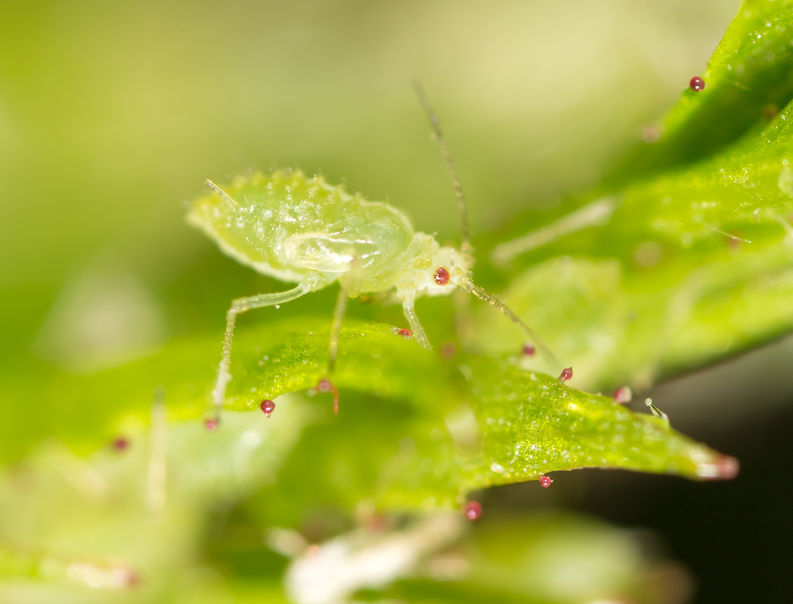
The forthcoming EU ban on insecticides will leave crops "vulnerable" to an attack from disease spreading aphids, experts have warned.
Within two years a virus outbreak will likely hit European crop yields, leading to a hike in food prices across the continent.
This is the message from more than 100 delegates from the UK’s governmental, scientific, industrial and farming sectors.
They gathered at research centre Rothamsted in Hertfordshire to discuss how an EU insecticide ban will leave crops open to attack from aphids that spread Barley Yellow Dwarf Virus, or BYDV.
Existing analyses suggest UK wheat yields would decrease by the equivalent of 4½ million loaves of bread a day because of the ban.
Lower yields could become a regular feature, as a disease-resistant wheat variety could be more than a decade away, says Dr Kim Hammond-Kosack, conference organiser and a senior plant pathologist at Rothamsted Research.
“Our scientists predict that in February and March 2020 farmers, will be looking out on virus infected, yellowing fields of winter wheat, and consequently later that year consumers will be buying and eating more expensive food stuffs made using wheat imports from Canada, America, and the Ukraine,” Dr Hammond-Kosack says.
“With few options to control these aphids, next year could be the last good year for European wheat harvests for some considerable time.”
Aphids are small sap-sucking insects. About 5,000 species of aphid have been described, all included in the family Aphididae. Around 400 of these are found on food and fibre crops, and many are serious pests of agriculture and forestry.
Dr Hammond-Kosack adds: “Currently no one has tested the UK’s recommended wheat varieties for their resistance to BYDV. Resistance to the virus has not been a breeding target for years because of the availability of effective insecticides.
“Given it takes seven or eight years to breed a new crop variety, and then two or three years of official testing before a variety can make it on the recommended list, you can see time is against us.”
'True scale of the problem'
Dr Gia Aradottir, an insect specialist at Rothamsted, said until the responses of recommended wheat varieties to the virus are correctly determined, “the wheat breeding industry will not know the true scale of the problem facing them.”
The threat of disease has arisen because of a EU-wide ban on the neonicotinoid insecticide currently used to control the aphids that spread BYDV.
The insects can still be controlled by a different class of insecticides called pyrethroids, but there is already a resistance mutation present in one of the species, the grain aphid, to these chemicals.
Analogous to antibiotic resistance that arises in many human diseases, insect populations can also develop a resistance to insecticides if they are over used.
“With the ban on the neonicotinoids, there is likely to be an increased use of pyrethroids which could hasten the development of this resistance, and could also select for insecticide resistance in the bird-cherry aphid, the other aphid species that spreads BYDV,” says Dr Aradottir.
“If we have another autumn of high aphid numbers next year, followed by a mild winter, then the outlook for wheat harvests in 2020 could be very bleak indeed.”
GM crops and neonics
Wheat is arguably the world’s most important crop, providing a fifth of an average person's calories.
Its genome – which is five times bigger than a human - was finally decoded earlier this year by an international consortium of scientists.
In the absence of a disease resistant wheat variety arising from classical crop breeding methods, gene modified or gene edited crops might produce an answer – but the growing of such crops is also currently banned in the EU.
Another route might be the development of a new insecticide, or a reversal on the current neonicitinoid ban.
Neonics, as they are commonly known, have been outlawed in the EU because of growing concerns over their impact on bee populations.
Loss of pesticide control
At this week's Wheat Genetic Improvement Network (WGIN) conference, a panel of experts will address this loss of pesticide control, and scientists are already urgently working on solutions.
They have already planted various wheat varieties without applying the insecticide to determine the likely impact of the ban on 2020’s harvests.
The Institute also has a study population of aphids infected with BYDV to test for resistance in common, old and wild wheat varieties.
And they have also recently developed a more sensitive diagnostic test to determine whether any commercial wheat varieties possess even a small amount of resistance that could be exploited by plant breeders.
“We already have a good breadth of expertise within the Institute to tackle this problem from all the important angles, including monitoring, diagnostics, aphid resistance, insecticide resistance and modelling,” says Dr Hammond-Kosack.
